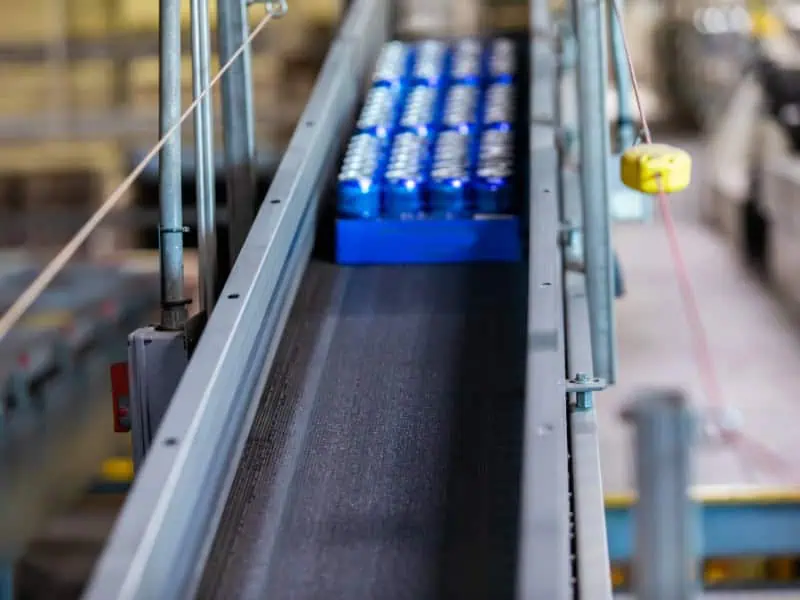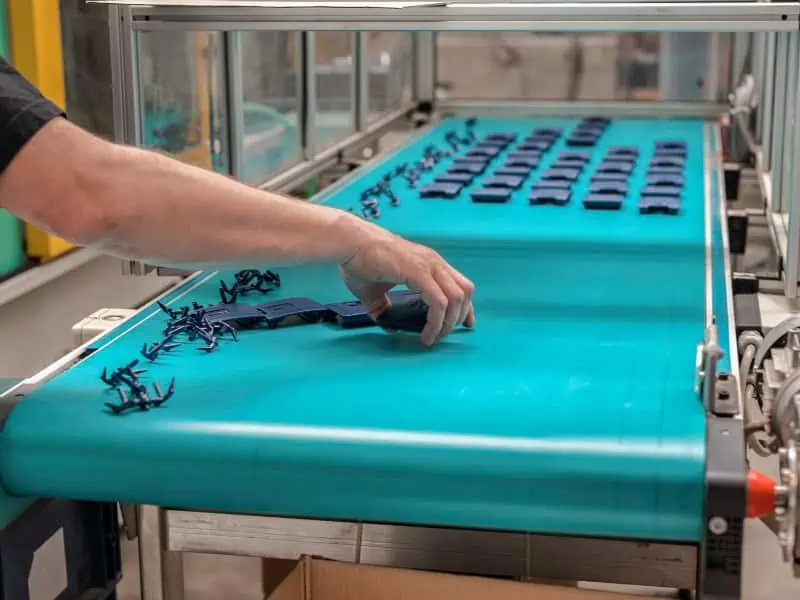Modern manufacturers need conveyor belts to orchestrate fast, consistent material flow that protects quality and worker safety. In a cut-throat market, even minor delays can snowball into missed deadlines and rising costs, making a factory conveyor belt the backbone of predictable throughput. Moreover, it enables traceability while freeing people from physically demanding tasks like lifting and pushing. This article unpacks the pain of manual movement, the pitfalls of legacy kit, and practical steps to choose and integrate smarter conveyors for Aussie factories.
What challenges do factories face without an efficient conveyor belt system?
Without an efficient system, material flow becomes stop-start and costly. In practice, lines stall, work-in-progress builds up, and quality checks arrive too late to help. Moreover, planners can’t forecast cycle times, so delivery dates slip and overtime balloons. Here are the challenges factories face without an efficient conveyor belt system:
- Labour bottlenecks: Staff spend time hauling parts instead of adding value.
- Unreliable cycle times: Queues form between stations, causing takt time to be blown out.
- Damage in transit: Parts get dented, scuffed or misplaced during manual moves.
- Space inefficiency: Walkways and staging consume floor space that could be used for production.
- Limited scalability: Volume spikes necessitate additional shifts rather than a more streamlined workflow.
- Data blind spots: Movement isn’t tracked, so issues hide until goods go bad.
In short, these headaches compound. With demand surges on the cards, the right conveyor design removes congestion and restores predictable, line-balanced flow.
How does manual material handling impact factory productivity and safety?
Manual handling slows everything down and increases risk. Fatigue creeps in, mistakes multiply, and consistency goes out the window. Plus, supervisors juggle rosters to cover injuries, which is a proper stitch-up for throughput. Here are the ways manual material handling impacts productivity and safety:
- Injury exposure: Awkward lifts and pushes can lead to sprains and back strains.
- Variable pace: Human speed fluctuates, upsetting downstream equipment cadence.
- Quality hit: Handling marks parts; inspection then catches problems too late.
- Lost focus: Operators spend energy walking loads instead of running processes.
- Compliance pressure: Risk assessments and reporting chew management time.
- Hidden costs, such as insurance, claims, and rework, erode margins quietly.
Consequently, the smart move is to eliminate manual lifts and long pushes through engineering. Prioritising workplace conveyor safety and operator training strengthens culture and keeps lines humming. Over time, injury risk decreases, productivity stabilises, and morale improves as reduced manual strain becomes the norm.
Why is outdated conveyor technology slowing down factory operations?
Older conveyors still move goods, but their limitations bite when volumes climb. Fixed speeds mismatch real demand, and alignment issues cause jams that halt everything. Meanwhile, spare parts for legacy gear are scarce, causing downtime to drag on. Here are the reasons outdated conveyor technology slows operations:
- Fixed-speed constraints: Belts can’t flex with upstream or downstream changes.
- Tracking problems: Misalignment causes rub, spill, and stoppages.
- Wear-heavy designs: Idlers and bearings fail, inviting risk of downtime.
- Non-modular layouts: Reconfiguring the line becomes expensive and slow.
- Limited sensing: No live data for queue lengths, temperatures, or slips.
- Integration gaps: PLC, MES, and robotic cells cannot communicate seamlessly.
Therefore, upgrades should focus on modularity, sensing, and variable speed. When the line is visible and adjustable, faults are isolated faster, leading to higher uptime and more planned maintenance. During redesign, consider selecting the ideal conveyor loading system for your site to stabilise infeed and keep belt wear in check.
How can a factory conveyor belt improve production efficiency and consistency?
A modern conveyor becomes a flow controller, not just a mover of things. By pacing work between stations, it protects quality, smooths takt, and reduces rework. Moreover, when sensors feed live data to control systems, the belt adapts before problems snowball. Here are the ways a factory conveyor belt improves efficiency and consistency:
- Balanced throughput: Accumulation zones protect bottlenecks and smooth peaks.
- Precision timing: Indexing and gating deliver parts at the right moment.
- Quality protection: Fewer touches mean lower product damage and scrap.
- Labour redeployment: People shift from carting goods to running higher-skill tasks.
- Real-time visibility: Sensors alert teams to slippage, overloads, or heat.
- Energy control: Drives ramp down when idle to save power between bursts.
| Metric (representative) | Manual/legacy handling | Modern conveyor flow |
| Units per hour | 60–120 | 300–600+ |
| Damage/defect rate | 2–5% | <0.5% |
| Labour for movement | 2–4 FTE | 0.5–1 FTE equivalent |
| Cycle time variance | High | ±1–2% |
For teams planning staged upgrades, trusted conveyor hire solutions can help bridge capacity gaps in industrial applications. At the same time, permanent systems are installed, keeping momentum and protecting delivery windows. All up, consistent flow stabilises schedules, reduces firefighting, and unlocks higher uptime across shifts.
Which factory conveyor belt type best supports high-volume manufacturing needs?

Choosing belt types depends on load, speed, environment, and cleaning requirements. Each option trades flexibility against robustness, so pick what serves your primary constraint first. Then design spares and maintenance around realistic wear patterns. Here are the factory conveyor belt types that support high-volume manufacturing:
- Modular plastic chain: Curves well, tough links, easy sanitation swaps.
- Flat belt (PU/PVC): Quiet, versatile, great for cartons and light assemblies.
- Roller/lineshaft: Simple for totes and pallets; zones make accumulation easy.
- Timing belt/synchronous: Accurate indexing for kitting and assembly tasks.
- Cleated/sidewall: Secure incline lift and bulk handling without roll-back.
- Magnetic or vacuum: Hold ferrous or light parts steady at speed.
For heavy hitters, belt construction and pulleys must withstand shock loads and heat. When evaluating specs, choosing the best conveyor belt for heavy-duty work clarifies materials, profiles, and when steel-cord options make sense. Select today’s bottleneck while preserving room for faster changeovers as SKUs evolve.
Can factory conveyor belts integrate with modern automation and robotics?
Yes—modern belts are built to handshake with robots, sensors, and software. With VSDs, encoders, and vision, the line becomes a synchronised loop that adjusts in real time. As a result, cycle time tightens and traceability becomes sweet. Here are the ways conveyor belts integrate with modern automation and robotics:
- Robot cells: Pick, place, and pack directly on timing belts or indexed rollers.
- Vision alignment: Cameras correct skew and verify orientation at speed.
- Data feedback: Edge devices push KPIs to MES/SCADA for live decisions.
- Smart safety: Light curtains and e-stops integrate with belt logic.
- Adaptive routing: Merges, diverts, and buffers manage surges without chaos.
- Energy tuning: Drives slow during lulls; energy costs can bite without this.
Done right, robots and belts amplify each other. Moreover, maintenance becomes predictive, and station-to-station balance holds even when product mixes shift. In the long run, faster changeovers and reliable pacing make upgrades feel like a walk in the park.
Final thoughts
Conveyors have shifted from “moving stuff” to orchestrating flow, quality, and data. With smarter drives and plug-and-play modules, you can scale lines without starting from scratch, and you avoid throwing extra labour at short-term spikes. Moreover, the proper transfer design stops defects at the gate and keeps throughput steady even when product mixes change overnight. If you’re mapping the next upgrade, anchor decisions in measurable takt, precise transfer geometry, and robust training plans; that approach saves cash and headaches down the line. For a straightforward next step, explore how Conveying & Hoisting Solutions enhances onsite productivity and discuss tailored configurations that meet your site’s specific constraints and objectives.




